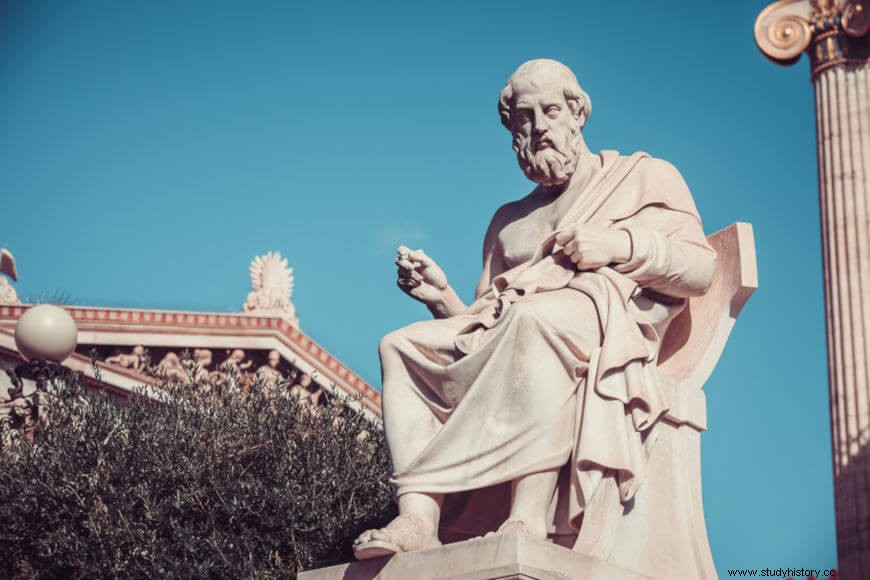
Myth of the Cave or Allegory of the Cave is a metaphor elaborated by Plato and contained in his work The Republic . The Republic is a political work of Plato who talks about the Athenian politics of Ancient Greece and presents Plato's thesis that relates knowledge to political power. According to the philosopher, the knowledge of the deepest truth provided only by reasoning is the fundamental condition for a ruler to have a good management.
The book is all built as a dialogue. The passage that presents the Allegory of the Cave is a dialogue between Socrates , main character, and Glaucon , a character inspired by Plato's brother. Socrates builds an exercise in imagination with Glaucon, telling the young man to picture in his mind a past situation inside a cave where prisoners were kept since birth.
Chained to a wall, they could only see the wall parallel to them. On this wall, shadows formed by a fire in a pit before the prisoners were projected. People passed with figurines and made gestures at the bonfire to project the shadows on the front wall to the prisoners, and they thought that all reality was those shadows, because their restricted world was limited to those experiences.
One day, one of the prisoners is freed and begins to explore the interior of the cave, discovering that the shadows he always saw were actually controlled by people behind the fire. The free man leaves the cave and finds a much broader and more complex reality than what he thought there was when he was still imprisoned.
At first, man feels very uncomfortable with sunlight, an element that his retinas were not used to and that momentarily blinds him. After some time of blurred vision, the man is able to see and realizes that reality and the totality of the world does not look like anything he had known until then.
Taken by a dilemma, of returning to the cave and running the risk of being judged as crazy by his companions or opening that new world, man learns that what he thought he knew before it was the deceptive fruit of their senses, which are limited.
Plato's intention is to present a hierarchical arrangement for the degrees of knowledge. There is a lower degree, which refers to knowledge gained through the body's senses (it is the type of knowledge that allows the prisoner to see only shadows) and a higher degree, which is rational knowledge, obtained outside the cave.
Also read: Discover the civilization of which Plato was a part
Book – The Republic
The Republic is a platonic dialogue divided into ten books. The philosopher's intention is to present his political theory, based on a kind of intellectual monarchy. Only philosophers, according to Plato, could, with their wisdom, deeply understand the concepts of good and justice.
Thus, it was only philosophers who could exercise politics understood as the pursuit of good deeds. Speaking of these political notions, Plato discusses knowledge and even aesthetics in The Republic. The Allegory of the Cave is in book VII of The Republic and aims to establish the perfect mode of government through pure intellection and rational knowledge.
What can you extract from the Myth of the Cave?
The elements arranged below have a meaning metaphorical in the Allegory of the Cave. We can understand them as follows:
-
The prisoners :the common men, the mass, the people, the prisoners are all of us, common people, who are content with the inferior degree of knowledge and do not seek rational knowledge.
-
The cave :it is our own body, which has a knowledge limited by the capture of the senses. The cave is everything that keeps us in the lower degrees of wisdom. The shadows on the cave wall are the fruits of our customary knowledge, which deceive us by showing themselves differently from what they really are.
-
The output of the cave:it is the movement towards rational and true knowledge. To abandon the cave is to abandon the empirical knowledge of our senses and concentrate forces to acquire wisdom through the understanding of rational concepts.
-
The light solar: the sunlight, which at first causes discomfort, is wisdom, the only one capable of making human beings really different from other animals and fully developed.
Also read: What if the Greeks hadn't existed?
The Cave Myth Today

Today knowledge and technology are overdeveloped, but there is no concern that makes people seek the purest and truest wisdom.
Various elements can be incorporated into a retelling of the Myth of the Cave today. Humans have been living in caves as prisoners for some time now. We have arrived in an era where knowledge, information and technology are overdeveloped , while there is not a concern, a disposition or any movement that makes people seek the purest and truest wisdom.
We live in the era da laziness , in which self-indulgence took over people due to the high technological development and extreme comfort provided. People are lazy to think, to doubt, to question, becoming mere receivers of information, resigned to what is said to them. We no longer seek to know why things are the way they are or the way they really are. There is only conformism.
The political and social development of the environment in which we live is no longer an interesting subject, and people simply surrender their rights for others to exercise them. Fake news spreads across social media and people simply believe it, as the prisoners believed the shadows were true. There is a real domination of the masses through the media and the owners of capital, who simply manipulate the popular will according to what benefits capital itself.
The networks social they have become showcases full of images that demonstrate people's happiness and enviable perfection, but also show egos devoid of meaning. Human life has become popular, because today's human being has chosen to remain in the cave, becoming an increasingly despicable, manipulable, weak and dominated being.
